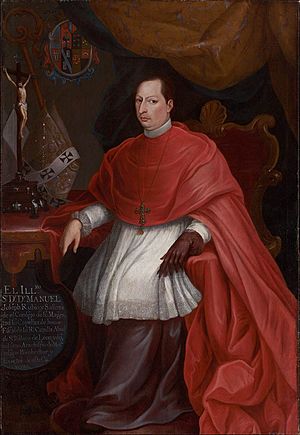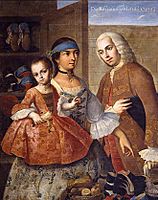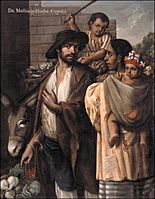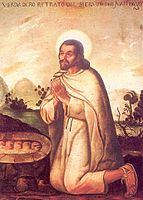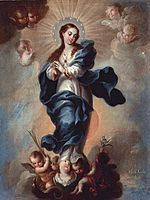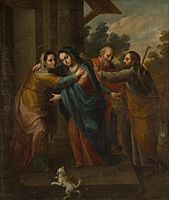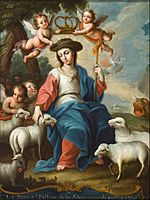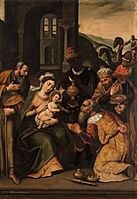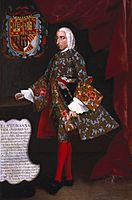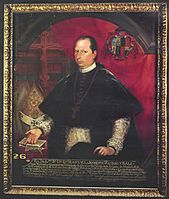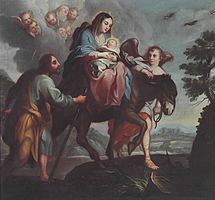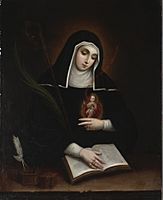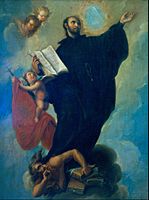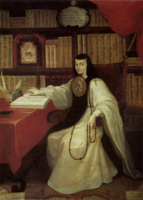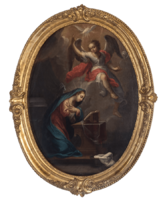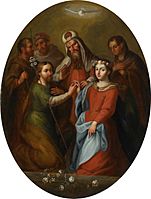Miguel Cabrera (painter) facts for kids
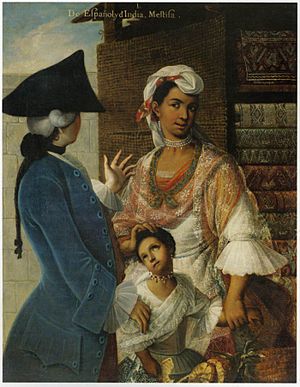
Miguel Mateo Maldonado y Cabrera (born 1695, died 1768) was a very famous painter from New Spain. This was the name for Mexico when it was ruled by Spain. He was born in Oaxaca but later moved to Mexico City, the capital. During his life, many people thought he was the best painter in all of New Spain. He created both religious art for the Catholic Church and art for wealthy people. His "casta" paintings are very well-known. These paintings showed families with mixed backgrounds, like people of Native American, Spanish, and African heritage. Cabrera's paintings came in many sizes, from tiny works on copper to huge pictures and wall paintings. He also designed parts of altars and monuments for graves.
Contents
Miguel Cabrera's Life Story
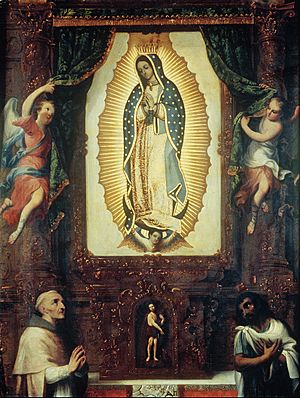
Miguel Cabrera was born in a city called Antequera, which is now Oaxaca. He moved to Mexico City in 1719. He might have learned painting from the Rodríguez Juárez brothers or José de Ibarra. Cabrera was a favorite painter of Archbishop Manuel José Rubio y Salinas. He painted the Archbishop's portrait two times. He was also liked by the Jesuits, a religious group, which gave him many painting jobs.
Studying the Virgin of Guadalupe
In 1756, Cabrera wrote an important book about the famous image of Our Lady of Guadalupe. The book was called Maravilla americana (American Marvel). In this book, Cabrera and six other painters carefully studied the painting. They looked at it like scientists, not just for religious reasons. They found that the painting used four different types of paint. Cabrera believed that no painter in the 1700s could use so many techniques. He also thought it was impossible for someone in the 1500s (when the image was made) to do it.
Cabrera was worried that many bad copies of the painting were being made. He knew that a painter from the 1600s, Juan Correa, used a special paper guide to make sure his copies were perfect. Cabrera's own workshop made many copies of the image. Some of these copies were even signed by Cabrera himself. He wanted his copies to be very true to the original. To make them even more special, some paintings had a note saying "touched to the original" with the date. In 1752, he was allowed to see the original image of Our Lady of Guadalupe again. He made three copies with the help of other painters. These copies were for his patron, Archbishop José Manuel Rubio y Salinas, for Pope Benedict XIV, and one to use for making more copies.
Cabrera's main goal with Maravilla Americana was to confirm that the image of the Virgin was truly miraculous. He also suggested that the image was made using many different painting styles. He thought the Virgin's face and hands were painted with oil, while her clothes and the angel at her feet were painted with egg tempera. Her cloak, he believed, was painted with a type of watercolor. He also noticed that the golden rays around the Virgin seemed to be dust woven into the fabric of the canvas. He said the fabric was a rough cloth made from palm fibers.
Raising the Status of Painters
Cabrera's work on the Guadalupe image was part of his bigger plan. He wanted painters to be seen as respected artists, not just as simple craftspeople. At the same time, the Mexican Archbishop Manuel José Rubio y Salinas wanted the Virgin of Guadalupe to be recognized as a special patron saint for everyone. A Jesuit priest helped with this in Rome. In 1754, Pope Benedict XIV gave Guadalupe her own special feast day.
In 1753, Cabrera started the second Academy of Painting in Mexico City and became its leader.
Most of Cabrera's other paintings were also religious. As the official painter for the Archbishop of Mexico, he painted many portraits, including the Archbishop's. In 1760, Cabrera painted The Virgin of the Apocalypse, which shows a scene from the Bible's Book of Revelation. He is also famous for his portrait of the poet Sor Juana Inés de la Cruz, painted after she had passed away.
Today, Cabrera is most famous for his casta paintings. One of these sixteen paintings was missing for many years. It was bought by the Los Angeles County Museum of Art in 2015. The museum heard that the last missing painting might be in Los Angeles, California.
In the 1800s, a writer named José Bernardo Couto called Cabrera "the perfect artist and painter." He said that even a century after Cabrera's death, his greatness was still clear. Miguel Cabrera is buried at the Church of Santa Inés in Mexico City.
Gallery
-
A casta painting, De Mestizo y d'India; Coyote, 1763, oil on canvas, Waldo-Dentzel Art Center
-
Don Juan Xavier Joachín Gutiérrez Altamirano Velasco, Count of Santiago de Calimaya, ca. 1752. Oil on canvas Brooklyn Museum
-
Doña María de la Luz Padilla y Gómez de Cervantes, ca. 1760. Oil on canvas. Brooklyn Museum
-
Miguel Cabrera. St. Ignatius of Loyola
-
Sor Juana Inés de la Cruz, Mexican nun and savante, posthumous portrait, oil on canvas, 1750
See also
 In Spanish: Miguel Cabrera (pintor) para niños
In Spanish: Miguel Cabrera (pintor) para niños
- Casta painting
- Mexican art



